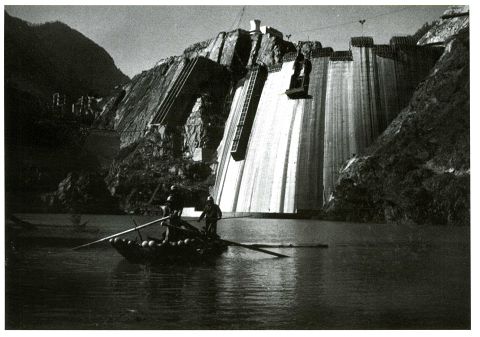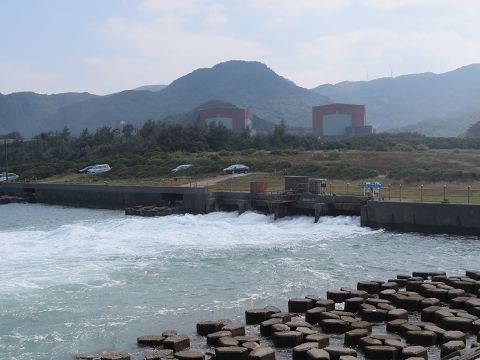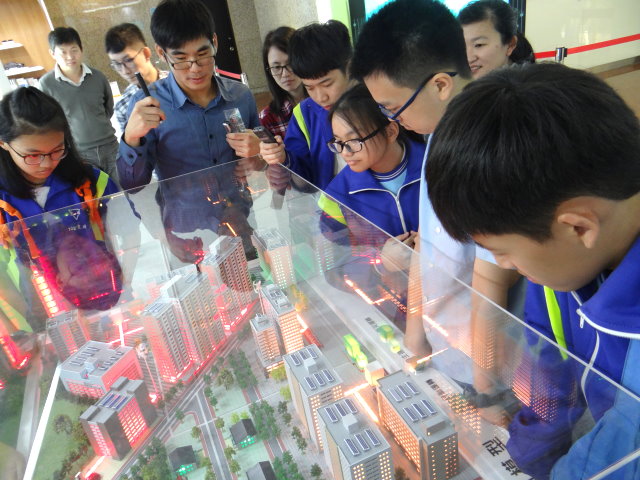|
 History ¢@ After Taipower Company
History ¢@ After Taipower Company

 1945 - 1953 After Retrocession from
Japan: A Focus on Hydro Power
1945 - 1953 After Retrocession from
Japan: A Focus on Hydro Power
In May 1946,
"Taiwan Power Company¡¨ was established. At that time, the
power generation equipment was dominated by "hydraulic
power." Sun Yun-Suan who had been 31st Premier of Taiwan led
the company to take over the all facilities which Japanese
left and repair all the electricity in Taiwan.
 1954 - 1965 Expansion Period: Hydro and Thermal Power
1954 - 1965 Expansion Period: Hydro and Thermal Power
In the 1950s, the country began to
develop industry, and the amount of thermal power generation
was gradually greater than that of hydraulic power, which
brought the power system into a period of "Hydro and Thermal
Power".

Building Te-Chi
Dam in 1970s
(Source: Taiwan Power Cultural Heritage exhibition)
¡@
 1966 - 1974 Developmental Period: Thermal First, Hydro
Second
1966 - 1974 Developmental Period: Thermal First, Hydro
Second
After the mid-1960s, Taiwan's
industry developed rapidly and the electricity consumption
increased. Taiwan Power Company successively developed
large-capacity and high-efficiency thermal power plants, and
the power system entered the stage of ¡§Thermal First, Hydro
Second¡¨.
 1975 - 1985 Diversification of Sources: Introducing of the
Nuclear Power
1975 - 1985 Diversification of Sources: Introducing of the
Nuclear Power
In the 1970s, two energy crises
occurred. The government adopted a multiple power generation
policy and listed nuclear power plants as one of the top ten
constructions. Nuclear plant 1, plant 2, and plant 3 have
joined the ranks of power generation. At the same time,
there were also high-efficiency thermal power plants, and
pumping water-powered generator plants, entering a period of
energy diversification.

Nuclear Power
Plant 2 and the outlet
 1986 - 1993 Period of Balanced Power Supply and Demand:
Demand Based Management
1986 - 1993 Period of Balanced Power Supply and Demand:
Demand Based Management
Taiwan's power reserve capacity is
gradually insufficient. In addition to the construction of
large-scale thermal power plants and the development of
water resources, Taipower has implemented measures such as
time price and electricity conservation, to achieve a
balance of power supply and demand.
 1994 -2000 Market Reform: IPP (Independent Power Producer)
appear
1994 -2000 Market Reform: IPP (Independent Power Producer)
appear
The global electricity industry
has moved toward liberalization since 1990, so the
government has followed this trend and accepted independent
power producers.
 2000 - 2010 Smart Grid
2000 - 2010 Smart Grid
The control center could remote
the power equipment, and even the equipment on the
distribution line by the power grid combined with artificial
intelligence (AI). It could detect, find out, and isolate
the fault automatically, even repower other fault-free range
when the distribution line would fail. We called it ¡§Smart
Grid¡¨.

Smart Grids
model in the Taipower Building
 2010 - Present Smart City
2010 - Present Smart City
In order to protect the earth, the
policy promotes energy conservation and carbon reduction and
develop renewable energy such as wind and solar energy to
reduce using fossil fuels. Smart City is an ideal final goal
which means a city could be divided into many areas and
build up their own micro-grid to generate power by
themselves.
 |